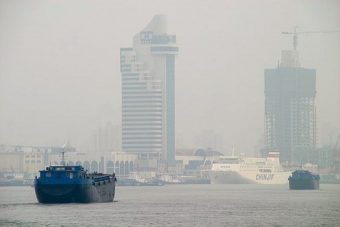
China is currently on track to install close to 50 GW worth of solar energy in 2017, nearly half of total global demand, but new research from Princeton University has concluded that China’s severe air pollution is “significantly reducing” the country’s solar energy output because the pollution is blocking light from the sun reaching solar installations.
China’s severe air pollution issues are no secret and have been a hot topic for years. Many will remember the 2008 Olympic Games held in Beijing, China, were beset by concerns for athletes’ health given the high levels of air pollution in the region. In 2009, research concluded that the Beijing Olympics were, unsurprisingly, the most polluted games ever.
But China has been making huge efforts to minimize its pollution levels, specifically as regards to pollution stemming from electricity generation. A study published last year concluded that coal combustion was the single largest source of air pollution-related health impact in China, contributing to 366,000 premature deaths in China in 2013 alone. One method that China has been relying on to reduce its energy-related air pollution is to transition toward renewable energy sources like solar. A report from 2014 revealed that China wanted to install 70 GW worth of solar by 2017 in an effort to reduce air pollution — an effort we can quite confidently say they achieved, considering China’s cumulative solar capacity at the end of the first half of 2017 was 112.34 GW.
However, all that hard work to reduce air pollution from coal combustion might be stuck in a circular loop of its own creation, according to new research from Princeton University and published in the journal, Proceedings of the National Academy of Sciences. Specifically, the study, Reduction of Solar Photovoltaic Resources Due to Air Pollution in China, found that severe air pollution in China is blocking the light from the sun reaching solar panels to such a degree that in the most polluted areas of northern and eastern China, aerosol pollution is reducing the potential solar electricity generation by as much as 35%.
“Developing countries with severe air pollution that are rapidly expanding solar power, such as China and India, often neglect the role of aerosols in their planning, but it can be an important factor to consider,” said Xiaoyuan (Charles) Li, a Ph.D. candidate in Princeton’s Department of Civil and Environmental Engineering and the study’s lead author.
The issue is worse in winter, as well, with air pollution’s wintertime effect on solar electricity generation as significant as that of clouds.
The researchers used a solar photovoltaic performance model combined with satellite data from NASA instruments that measure irradiance from the sun and analyze aerosol components and clouds in the atmosphere. They conducted nine separate analyses spanning from 2003 to 2014 covering all of China in an effort to compare the impact of aerosols compared to clouds on solar electricity generation.
“Reduction in solar generation due to clouds has been a primary focus in the past,” said Denise L. Mauzerall, a professor of environmental engineering and international affairs at Princeton’s School of Engineering and Applied Science and the Woodrow Wilson School of Public and International Affairs who serves as Li’s faculty adviser and helped develop the study. “But this is the one of the first times atmospheric air pollution has been taken into account in determining solar photovoltaic cells’ ability to generate electricity.”
Source: cleantechnica.com



